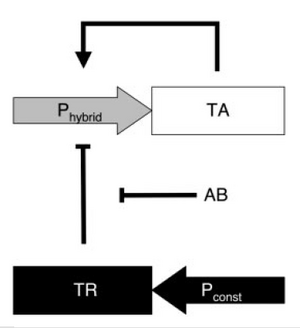Difference between revisions of "CellularMemory:Hysteresis in Mammalian Cells"
From GcatWiki
Wideloache (talk | contribs) |
Wideloache (talk | contribs) |
||
| Line 3: | Line 3: | ||
=<center>Synthetic Hysteresis in Mammalian Cells</center>= | =<center>Synthetic Hysteresis in Mammalian Cells</center>= | ||
==Overview== | ==Overview== | ||
| − | [[Image:Hysteresis.png|thumb|300px| | + | [[Image:Hysteresis.png|thumb|300px|right|'''A graphical depiction of [http://en.wikipedia.org/wiki/Hysteresis hysteresis].''' Arrows indicate the direction of movement from one state to another. For a system that exists in the low output state initially (red line), a relatively high level of input is required to induce a change to a high system output. For a system that exists in the high state initially (blue line), a relatively low level of input is required to induce a change to a low system output. In other words, more extreme amounts of input are required to move out of a state than are required to move into a state (meaning that the system resists a change of state).]] |
[[Image:Linebreak.png]] | [[Image:Linebreak.png]] | ||
==Biological Design== | ==Biological Design== | ||
| − | [[Image:Hysteresis design.png|thumb|300px| | + | [[Image:Hysteresis design.png|thumb|300px|right|The biological design of hysteresis.]] |
[[Image:Linebreak.png]] | [[Image:Linebreak.png]] | ||
==Mathematical Model== | ==Mathematical Model== | ||
Revision as of 17:45, 20 November 2007
Error creating thumbnail: Unable to save thumbnail to destination
Main Page | Biological Designs | Mathematical Models | Toggle Switch | Hysteresis | Permanent Memory | Conclusions | References
Contents
|
